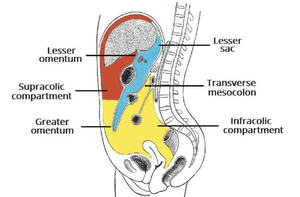Topography of Peritoneal cavity
The peritoneal cavity is a potential space between the parietal and visceral peritoneum (a continuous membrane that lies in the abdominal cavity and covers the abdominal viscera). It normally contains a thin film of peritoneal fluid which enables the free movement of the abdominal viscera (organs) and antibodies in the fluid for fighting infection. Whilst the peritoneal cavity is ordinarily filled with only a thin film of liquid, it is known as a potential space as excess fluid can accumulate in it.
The peritoneal cavity can be subdivided into Greater and Lesser sac.
Greater Sac[edit | edit source]
Is the larger portion of the peritoneal cavity. It is further subdivided into two compartments via the mesentery of the transverse colon (transverse mesocolon)
1.) Supracolic compartment: Lies above the transverse mesocolon and contains the stomach, the liver and the spleen.
2.) Infracolic compartment: Lies below the transverse mesocolon and contains the small intestine, ascending colon and the descending colon.
The supracolic and infracolic compartments are connected by the paracolic gutters which lie between the posterolateral abdominal wall and the lateral aspect of the ascending or descending colon.
Lesser Sac (Bursa omentalis)[edit | edit source]
- Lies posteriorly to the stomach and lesser omentum
- It allows the stomach to move freely against the structures posterior and inferior to it
- The omental bursa is connected to the greater sac through an opening in the omental bursa, known as the epiploic foramen (of Winslow)
- The epiploic foramen is situated posterior to the free edge of the lesser omentum (the hepatoduodenal ligament)
Borders:
- Anterior - lesser omentum, visceral peritoneum along the posterior stomach and gastrocolic ligament
- Left - Gastrosplenic and splenorenal ligaments
- Right - Epiploic foramen
- Posterior - Visceral/parietal peritoneum covering the diaphragm, pancreas, left kidney, left adrenal gland and duodenum, and transverse mesocolon
- Superior - Peritoneum covering caudate lobe of liver
Recesses of the lesser sac (A recess is a space created by the peritoneum hanging over the viscera):
- Superior (hepatic) recess: Between the caudate lobe of the liver and diaphragm
- Splenic recess: Between the splenic ligaments and the stomach
- Inferior (omental) recess: Between the stomach and the transverse colon
The lesser sac communicates with greater sac via epiploic foramen (of winslow) posterior to free edge of lesser omentum. The borders of the foramen are:
- Anterior – hepatoduodenal ligament
- Posterior – inferior vena cava and right crus of diaphragm
- Superior – caudate lobe of liver
- Inferior – superior part of duodenum





